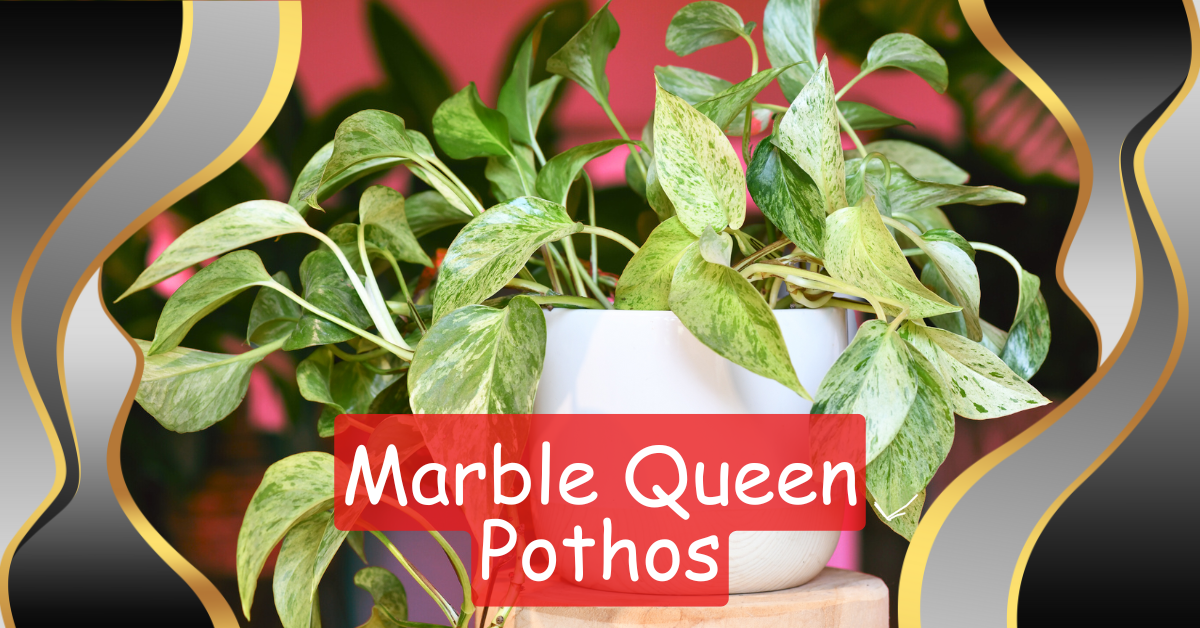Introduction: 7 Essential Tips for Thriving Marble Queen Pothos
The Marble Queen Pothos is a stunning, low-maintenance indoor plant known for its variegated foliage that blends beautiful shades of green and creamy white. This plant, a variety of the well-loved Pothos (Epipremnum aureum), is not only visually striking but also incredibly easy to care for. Whether you’re a seasoned plant lover or a beginner looking for your first indoor plant, the Marble Queen Pothos offers a touch of elegance and a host of benefits, including air purification.
In this comprehensive guide, we’ll cover 7 essential tips to help your Marble Queen Pothos thrive, from understanding its specific care needs to addressing common problems. By the end, you’ll know how to keep this beautiful plant healthy and vibrant for years to come.
What is a Marble Queen Pothos? Understanding the Plant
The Marble Queen Pothos is a highly sought-after variety of the Pothos family, prized for its unique variegation. The plant’s heart-shaped leaves feature a striking mix of green and white, which not only makes it a standout in any indoor garden but also provides an ever-changing display as the plant grows.
Origin and Appearance
The Marble Queen Pothos originates from the tropical forests of Southeast Asia, where it thrives in low-light environments. Its natural habitat allows it to adapt well to indoor conditions, making it a perfect plant for homes and offices. The plant’s vines can grow quite long, creating a trailing or climbing effect depending on how you choose to display it.
Why It Stands Out
Unlike other Pothos varieties, such as the Golden Pothos or Jade Pothos, the Marble Queen’s variegation gives it a unique appearance that adds depth and texture to any indoor space. Its versatility, coupled with its ability to thrive in various light conditions, makes it one of the most popular indoor plants today.
How to Care for Marble Queen Pothos: Light, Watering, and Soil Requirements
Despite its exotic appearance, the Marble Queen Pothos is known for being low-maintenance. However, understanding its basic care requirements will help ensure that it remains healthy and grows beautifully.
1. Light Requirements
The Marble Queen Pothos prefers bright, indirect light to maintain its variegation. Too much direct sunlight can scorch its leaves, while low light may cause the plant to lose its white variegation and revert to solid green.
- Ideal Light: Place your plant near a north- or east-facing window, where it will receive plenty of filtered sunlight.
- Avoid: Prolonged exposure to direct sunlight or very dim light for long periods.
2. Watering Tips
One of the most important aspects of Marble Queen Pothos care is maintaining a proper watering schedule. Overwatering can lead to root rot, while underwatering can cause the leaves to wilt and brown.
- Watering Schedule: Water when the top inch of soil feels dry. Typically, this means watering once every 1-2 weeks, depending on the humidity levels in your home.
- Drainage: Always ensure that your plant’s pot has proper drainage to prevent water from pooling at the bottom, which could lead to root rot.
3. Best Soil for Marble Queen Pothos
The Marble Queen Pothos thrives in well-draining potting soil that retains some moisture without becoming soggy. A high-quality indoor potting mix works best, and you can mix in some perlite or coco coir to improve drainage.
- Soil Mix: Choose a light, aerated soil mix designed for houseplants. Adding some perlite or peat moss can help ensure the soil drains well while retaining enough moisture for the plant’s roots.
Marble Queen Pothos Propagation: A Simple Guide
One of the best things about Marble Queen Pothos is how easy it is to propagate. By taking a simple stem cutting, you can grow new plants to expand your collection or share with friends.
Step-by-Step Propagation
- Select a Healthy Stem: Choose a healthy vine with several leaves and at least one node (the small bump where roots will grow).
- Cut Below the Node: Using clean scissors, cut just below the node.
- Place in Water: Place the cutting in a jar of water, making sure the node is submerged.
- Wait for Roots to Grow: After about 2-4 weeks, roots should begin to form. Once the roots are about an inch long, the cutting is ready to be planted in soil.
Propagating in Soil
Alternatively, you can propagate directly in moist soil. Just follow the same cutting process and plant the node in the soil, keeping it moist until roots take hold. This method works well, but root growth might be slower than water propagation.
Pruning and Training Marble Queen Pothos for Healthier Growth
Pruning is an essential part of Marble Queen Pothos care. Regular pruning encourages bushy growth and prevents the plant from becoming too leggy. You can also train your Pothos to grow in different ways, depending on how you display it.
1. Pruning for Health and Aesthetic
Trim the vines regularly to maintain a compact shape. Pruning helps remove dead or yellowing leaves, encourages new growth, and can even help your plant produce denser foliage. Aim to prune just above a leaf node to encourage new shoots.
2. Training the Plant
The Marble Queen Pothos can be trained to trail down from a hanging basket or climb up a trellis or moss pole. To encourage upward growth, use soft ties or plant clips to gently attach the vines to your support structure.
Common Problems and How to Fix Them
Even though Marble Queen Pothos is relatively easy to care for, it can still encounter a few common problems. Here are some issues you might face and how to resolve them:
1. Yellowing Leaves
Yellow leaves can be a sign of overwatering. Make sure the soil is not waterlogged and allow it to dry out between waterings. Also, check for proper drainage in the pot.
2. Slow Growth
If your Marble Queen Pothos is growing slowly or not at all, it could be due to insufficient light. Move the plant to a brighter location but avoid direct sunlight. You can also try fertilizing once a month during the growing season to give the plant a nutrient boost.
3. Pests
Like many houseplants, Marble Queen Pothos can attract spider mites, mealybugs, and aphids. Regularly inspect the plant, and if you spot pests, treat them with insecticidal soap or a mixture of water and dish soap.
Decorating With Marble Queen Pothos: Creative Ideas for Your Space
The Marble Queen Pothos is not only easy to care for but also versatile in terms of decoration. Its trailing vines make it perfect for hanging baskets or draping over shelves, adding a touch of greenery to any room. You can also train it to climb a moss pole or a trellis, turning it into a living piece of art. The plant’s beautiful variegation complements various interior styles, from modern minimalism to bohemian chic. Consider placing it near a north-facing window or even using it as a centerpiece on a bright countertop.
For more exciting blogs, visit our homepage Magzineco.
Conclusion: Why Marble Queen Pothos is a Must-Have Indoor Plant
The Marble Queen Pothos is a versatile and stunning plant that adds a touch of natural beauty to any indoor space. Its easy care requirements, beautiful variegated leaves, and adaptability make it a popular choice for both beginner and experienced plant lovers. With just a little attention to light, water, and pruning, your Marble Queen Pothos will thrive and reward you with lush, trailing vines.
Whether you’re looking for a low-maintenance plant to brighten your home or a standout piece for your indoor garden, the Marble Queen Pothos is a must-have. Its ability to purify the air, combined with its aesthetic appeal, ensures that it will remain a favorite for years to come.
FAQs About Marble Queen Pothos Care
- How much light does a Marble Queen Pothos need?
- The Marble Queen Pothos thrives in bright, indirect light, but it can tolerate lower light conditions. However, in lower light, its variegation may fade.
- How often should I water my Marble Queen Pothos?
- Water your Marble Queen Pothos when the top inch of soil feels dry. Typically, this means watering every 1-2 weeks, but adjust based on your home’s humidity levels.
- Can Marble Queen Pothos grow in low light?
- While the plant can survive in low-light conditions, it grows best in bright, indirect light. Prolonged low light may cause the variegation to fade.
- What is the best way to propagate Marble Queen Pothos?
- The easiest way to propagate is through water propagation. Simply cut below a node and place the cutting in water until roots develop.
- How do I prevent yellowing leaves on my Marble Queen Pothos?
- Yellow leaves are often caused by overwatering. Make sure the plant has good drainage and only water when the top inch of soil is dry.
- Does Marble Queen Pothos need fertilizer?
- Fertilize the plant once a month during the growing season (spring and summer) with a balanced liquid fertilizer to support healthy growth.
- Can Marble Queen Pothos be grown outdoors?
- Yes, Marble Queen Pothos can be grown outdoors in warm, tropical climates where temperatures don’t drop below 50°F (10°C).
- What kind of soil is best for Marble Queen Pothos?
- Use a well-draining indoor potting mix with added perlite or coco coir for optimal drainage.
- How do I keep my Marble Queen Pothos variegation bright?
- To maintain the variegation, ensure the plant receives bright, indirect light. Too much shade can cause the white markings to fade.
- Is Marble Queen Pothos toxic to pets?
- Yes, like other Pothos varieties, Marble Queen Pothos is toxic to pets if ingested, so keep it out of reach of cats and dogs.




